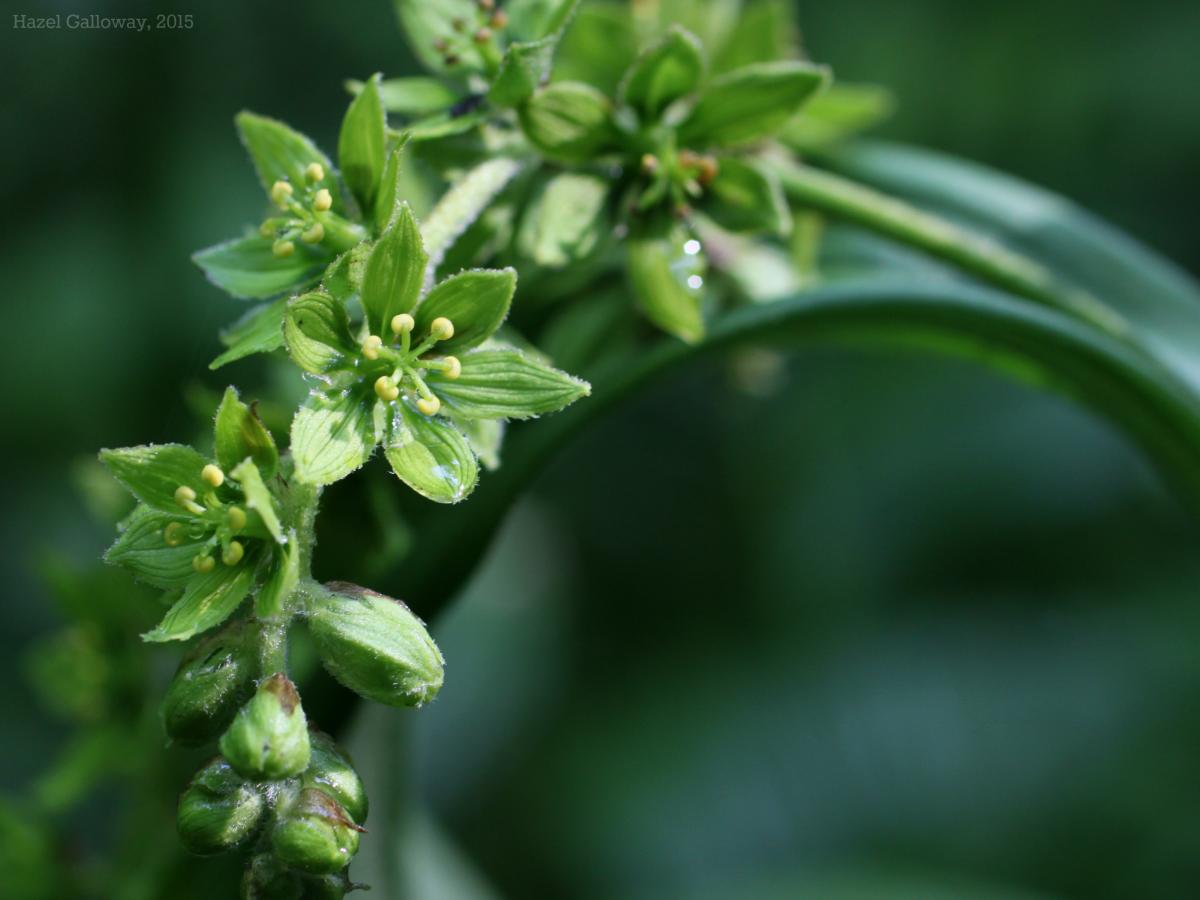The robust, deep green leaves and delicately drooping pale green flowers of this marsh-dwelling plant do little to suggest its deadly poisonous qualities. Veratrum viride stems, roots and leaves contain over 50 kinds of steroidal alkaloids, compounds which interfere with the sodium-gated channels that generate electrical impulses used to transmit signals to and from the brain and spinal column. Steroidal alkaloids prevent repolarization (a return to “ready status”) in neurons after a signal is transmitted, which results in multiple depolarizations (firings) of a nerve cell in response to a single stimulus. When multiple depolarizations occur in the vagus nerve, which partially regulates the circulatory system, it leads to the Bezold-Jarisch reflex: lower blood pressure, reduced the heart rate, and shortness of breath.
This effect can be deadly in humans and livestock. Historically, human deaths due to V. viride were often caused by poorly standardized doses administered medically to treat hypertension. However, the mid-1900s saw the successful introduction of a class of regulated drugs under the trade names Alkavervir, Veriloid, and Vergitryl to treat high blood pressure.
These toxic compounds likely serve the plant as a deterrent against herbivory by both vertebrates and invertebrates. However, at least one species of sawfly (Rhadinoceraea nodicornis) has been shown to sequester the alkaloids in its body after feeding on the leaves of a closely related plant, providing the sawflies with a potent hand-me-down defense against predators.
V. viride belongs to the family Melanthiaceae, known as the death camas. The genus likely originated in East Asia and radiated across the Northern Hemisphere; this species can be found throughout most of the east coast of the United States into Canada, with a disjunct population occurring on the west coast of the US. The perennials appear in spring in low, wet habitats such as swamps, bogs, stream banks, and moist forests or meadows. Individuals can reach 2 m in height and sport alternate 10-35 cm. leaves which lack stalks, instead clasping directly onto the stem. The prominent parallel ribs on the leaves serve as another distinguishing characteristic. Six-petaled green flowers appear in clusters near the apex of the plant in June and July, and develop into small fruit capsules containing many flat, winged seeds.
The first recorded use of the Latin “veratrum” appears in a 14th-century manuscript penned in Paris by the monk Bartholomeus Anglicus, reading “þe Romayns clepeþ þis herbe Veratrum, … and þerof is twei manere of kinde, white & blacke.” By the 1600s, the word was used synonymously with “hellebore,” although true hellebores today are found instead in the genus Helleborus.
These plants were collected in a marshy, open area in Pond Drain, near the beginning of White Pine Road. See larger photo.
Hazel Galloway
Sources:
- Freis, E. D., and J. R. Stanton. "A Clinical Evaluation of Veratrum Viride in the Treatment of Essential Hypertension." American heart journal 36.5 (1948): 723-38.
- Jaffe, A. M., D. Gephardt, and L. Courtemanche. "Poisoning Due to Ingestion of Veratrum Viride (False Hellebore)." The Journal of emergency medicine 8.2 (1990): 161-7.
- Schep, Leo J., David M. Schmierer, and John S. Fountain. "Veratrum Poisoning." Toxicological reviews 25.2 (2006): 73-8.
- Schaffner, Urs and Jean-Luc Boevé. Sequestration of plant alkaloids by the sawfly Rhadinoceraea nodicornis: ecological relevance for different life stages and occurrence among related species. Entomologia Experimentalis et Applicata 80: 283-285, 1996.
- "veratrum, n." OED Online. Oxford University Press, March 2017. Web. 22 March 2017.
- Liao, WJ., Yuan, YM. & Zhang, DY. Plant Syst. Evol. (2007) 267: 177. doi:10.1007/s00606-007-0528-z
- http://research.vet.upenn.edu/PoisonousPlantsofPA/%20Veratrumviride/tabid/5487/Default.aspx
- http://www.sigmaaldrich.com/life-science/nutrition-research/learning-center/plant-profiler/veratrum-viride.html
- http://linnet.geog.ubc.ca/Atlas/Atlas.aspx?sciname=Veratrum+viride




